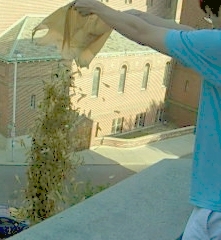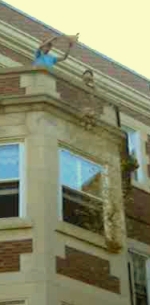
|
Old writings of mine: (Newer papers may be found at this arXiv link)
- Spring 2009:
- Towards an Analytical 2D Foam Solver: Solving Mancini's Equations and Related Problems After reading an inspiring thesis by Dr. Marco Mancini, I wrote a Mathematica notebook which can create images of 2D equilibrium foams given a bubble topology. The notebook is interactive, in that there are sliders which control the pressures inside each of the cells of the bubble. The novel thing about this program is that it is done all analytically (essentially via solving Mancini's equations). There are still several outstanding issues which I describe in the writeup linked to above. Here is the Mathematica notebook. Here is a version compatible with the free Mathematica player. Please email me with any comments!
- Older writings:
|
Talks:
I'll put some more talk slides here in the future, until then feel free to email me for slides of any talks mentioned in my CV.
- On December 3-5, 2012 the PCTS held a workshop ``Through the Looking-glass: a Glimpse into the Geometry and Topology of Materials''. I gave a talk entitled Building with butterflies: folding concentric pleated polygons . I describe some results and numerical experiments studying rigid origami crease pattern consisting of concentric polygons folded alternately as mountain and valley creases, including the famous ``hypar''. It turns out that the continuum limit of the origami hypar isn't always the smooth quadric surface z=x^2/a^2-y^2/b^2. I still hope to be able to finish a paper on these results soon. In the meantime have a look at the slides.
- May 4, 2011 was the UPenn Art of Research Graduate Symposium. I gave a talk entitled The river banks of Ellsworth Kelly's Seine relating a painting I saw in the Philadelphia Museum of Art to a statistical physics model called gradient percolation. (I was awarded second place and $250!) The linked folder contains my slides in PDF format. I hope to include some Mathematica notebooks and images in there at some point too.
|
Links to friends and acquaintances:
These are some young science postdocs and grad students to keep your eye on:
- Jim "Peg Leg" Halverson. A budding string theorist, who I was honored to share an office with. An all-around great guy and chess player.
- Tiffany Chen. A biomedical informaticist who was formerly at Stanford. We've known each other since before we were potty trained.
- Steven Byrnes. A materials scientist and physicist formerly at Berkeley. My freshman roommate and teammate from this high school thingy.
- Takuya Kitagawa (北川拓也). A data scientist, formerly an ultracold atom theorist at Harvard. A dynamic soccer player and celebrity author.
- Carl Modes. A former fellow group member. A mighty softball player and thinker on curved spaces.
- Vincenzo Vitelli. A former postdoc in the group who does (a lot of) interesting stuff. He's now a professor (and my boss), so maybe I should remove him from this list!
- Sujit Datta. An energetic experimentalist. Once a precocious undergrad at Penn, then a precocious grad student at Harvard. He is a fan of hard ellipsoids.
- Sabetta Matsumoto. A fellow student of Randy's. She makes the some of the prettiest images and talk slides I've seen.
|

|
Miscellaneous
There are many things which are miscellaneous.
-
When I was taking the first semester of field theory, I began
LaTeXing up Sidney Coleman's lecture
notes, from the course Physics 253a at Harvard. These notes were
written by Brian Hill around 20
years before I took the course from L. Motl in the fall of 2006
(based on these notes, and Peskin and Schroeder). I got around 11
lectures done (out of 28) before the difficulty of doing Feynman
diagrams easily made it impossible to continue. There things stood
from about 2008 to late 2010. Then, TING Yuan
Sen typeset lectures 12 through 28 - all of them! We have
completed a first round of editing this work on March 14, 2011 and I have
uploaded a somewhat polished version of all the lectures combined in
one file. Brian Hill has also contributed a preface to this document.
See Notes from Sidney Coleman's Physics 253a which we have placed on the arXiv.
An obsolete version of the source files (up to date other than lecture
01-0923) are contained in this ZIP
file. Note that I also fixed some swapped pages in the
1-214 scanned notes.
You'll need the
feyn font, and the wick.sty
file among other packages, if you want to compile our LaTeX
files. Lecture 12 requires
axodraw4j.sty.
For more details of this sort, see this file.
Rest in peace, Prof. Coleman.
- some ``open'' perturbation theory questions! Last updated 20081110 or so.
|

|
Last updated 20161026
|



